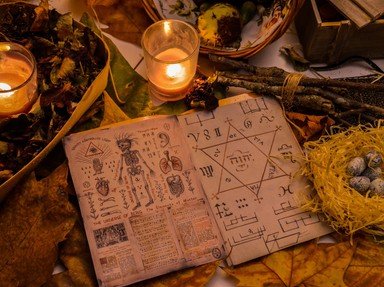Quiz Answer Key and Fun Facts
1. How many Sabbats are there in a year?
2. The word "Sabbat" comes from the old Greek word _______, meaning "to rest."
3. This Sabbat falls on October 31. It marks the end of the third and final harvest, it is a day to commune with and remember the dead, and it is a celebration of the eternal cycle of reincarnation.
4. This Sabbat falls on December 22, where the God (who died at the previous Sabbat) is reborn of the Virgin Goddess. The God is represented by the sun which "returns" after this darkest night of the year to again bring warmth and fertility to the land.
5. This was not originally a Sabbat as we think of one today, but a special day set aside to honor the goddess who was slowly turning the Wheel of the Year back to spring. It takes place on February 2nd.
6. The Spring Equinox falls on March 22nd. It is also known as:
7. This fertility Sabbat falls opposite Samhain on the Wheel of the Year. These were the two most important Sabbats on the Celtic calendar, marking the beginning and end of the two recognized seasons.
8. This Sabbat marks the time of the Summer Solstice, the longest day of the year, the height of the sun's power.
9. This is the first of the three harvest Sabbats. It falls on August 1st or 2nd.
10. The Autumn Equinox falls on September 22nd. It is also known as:
Source: Author
SilverMoonsong
This quiz was reviewed by FunTrivia editor
crisw before going online.
Any errors found in FunTrivia content are routinely corrected through our feedback system.

